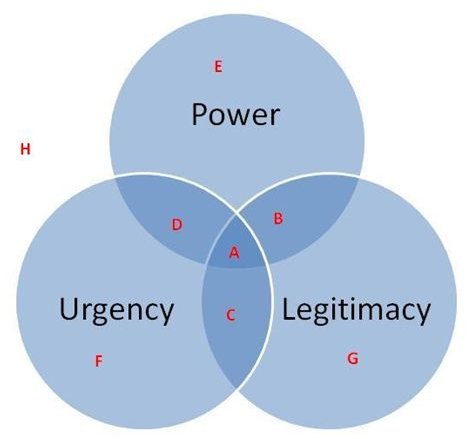Understanding the Salience Model for Project Stakeholders
Introduction
The Salience Model for project stakeholders was developed by Mitchell, Agle, and Wood to help managers identify and analyze project stakeholder needs. Unlike, the <strong>Power/Interest</strong> or Power/Influence grids, the Salience Model uses three parameters to categorize stakeholders: Power, Legitimacy and Urgency. Each parameter is defined as follows:
- Power: Is the ability project stakeholders has to influence the outcome of an organization, deliverables, or a project
- Legitimacy: Is the authority, level of involvement project stakeholders have on a project.
- Urgency: Is the time expected by project stakeholders for responses to their expectations.
This three-dimensional view of project stakeholders needs and expectations from a project can help managers narrow down the critical stakeholders.
The Salience Model Diagram
The Salience Model for project stakeholders is graphically depicted as a Venn diagram. Each assessment parameter has a major circle and the intersections of each major circle helps you identify project stakeholders that have multiple needs.
_
Image created by Rupen Sharma
Mitchell, Agle, and Wood related each area within the Venn diagram to a specific type of stakeholder. Mentioned below is a description of each type of project stakeholder as per the Salience Model:
A) Core: These are the critical project stakeholders. As a Project Manager, you need to provide focused attention to these stakeholders.
B) Dominant: Such project stakeholders have power and legitimacy, but do not have urgency. You should focus on their expectations, but always there is not a lot of urgency.
C) Dependent: As per the Salience Model, these project stakeholders have no real power on the project. However, they need to be managed because they can quite easily choose to align themselves with other project stakeholders and hence influence your project.
D) Dangerous: Appropriately named classification, these stakeholders have power and urgency, but no legitimacy. Imagine a very senior person trying to force her views on the outcome of your project, without really being a part of it! A Project Manager needs to keep such stakeholders appropriately engaged or satisfied.
E) Latent: Possibly the best category project stakeholders. These stakeholders only get into the project, if there is something has gone horribly wrong with it. Over-communication of micro-level details with them is also not a great thing to do.
F) Demanding: Such stakeholders in the Salience Model are people that always seem to think that their work needs your immediate attention. If you spend too much time and effort on these stakeholders, you won’t actually gain to much project mileage. There are other more important people to work with.
G) Discretionary: Another wonderful classification of project stakeholders. Give them regular status updates and they’ll be happy.
H) Non-stakeholders: These people are not stakeholders in the project. Investing time and effort on such people will not help you shape the outcome of your project in any manner.
Note: During the course of a project, stakeholders may traverse from one category to another, depending on the project scenario. For example, when making decisions by using decision trees will require a different set of stakeholders than a while working with people on <strong>methods to shorten the critical path</strong>.
As you can see, the Salience Model for project stakeholders is an essential tool for use during stakeholder analysis.
